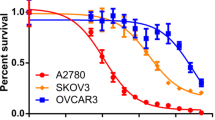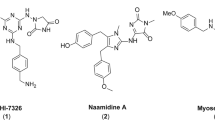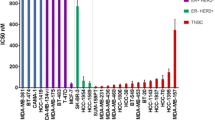Abstract
Purpose
Voreloxin, formerly known as SNS-595 or AG-7352, is a novel naphthyridine analog currently under investigation for the treatment of ovarian and hematologic malignancies. Voreloxin mechanism of action includes DNA intercalation and inhibition of topoisomerase II that causes selective DNA damage. In this study, we describe the anti-proliferative activity of voreloxin in a wide range of in vitro and in vivo models of human cancers.
Methods
The cytotoxicity of voreloxin in vitro was examined by MTT assay in 15 cell lines, including 4 drug-resistant lines. Activation of caspase in cell lines and tumors was evaluated by immunohistochemistry. Anti-tumor activity was assessed in 16 xenograft and 3 syngeneic tumor models in mice. Tumors were allowed to grow to approximately 150 mm3 prior to treatment with voreloxin or comparator drugs. Activity of the anti-cancer agents was determined by calculating the inhibition rate (IR = [1 − (average tumor weight treated/average tumor weight control)] × 100%) and survival ratio (number surviving mice/number of mice per group at start of study) for each agent and dose and schedule tested.
Results
In vitro studies demonstrated voreloxin has broad anti-proliferative activity in 11 tumor cell lines, with IC50 values ranging from 0.04 to 0.97 μM. Similar activity was observed in vitro in drug-resistant cell lines, including those that overexpress P-glycoprotein and have reduced topoisomerase levels. After a single intravenous dose, voreloxin concentrations in tumor were correlated with induction of the apoptosis marker caspase-3. The optimal dose and schedule was established using a KB nasopharyngeal carcinoma xenograft model. Administration of voreloxin at 20 mg/kg weekly for five doses effectively inhibited tumor growth (86%). Voreloxin demonstrated strong dose-dependent tumor growth inhibition (63–88%) in 10 of 11 solid tumor (breast, ovarian, colon, lung, gastric, and melanoma) xenograft models, 2 hematologic tumor xenograft models, 3 multidrug resistant tumor models and 3 murine syngeneic tumor models (Colon 26, Lewis Lung carcinoma, M5076 Ovarian Sarcoma).
Conclusions
These data demonstrate that voreloxin is a broadly active anti-tumor agent in vitro and in vivo, with potent activity in aggressive and drug-resistant tumor models.




Similar content being viewed by others
References
Jemal A, Siegel R, Ward E, Murray T, Xu J, Thun MJ (2007) Cancer statistics. CA Cancer J Clin 57:43–66
Tomita K, Tsuzuki Y, Shibamori K-I, Tashima M, Kajikawa F, Sato Y, Kashimoto S, Chiba K, Hino K (2002) Synthesis and structure-activity relationships of novel 7-substituted 1, 4-dihydro-4-oxo-1-(2-thiazolyl)-1, 8-naphthyridine-3-carboxylic acids as antitumor agents. Part 1. J Med Chem 45:5564–5575
Tsuzuki Y, Tomita K, Shibamori K-I, Sato Y, Kashimoto S, Chiba K (2004) Synthesis and structure-activity relationships of novel 7-substituted 1, 4-dihydro-4-oxo-1-(2-thiazolyl)-1, 8-naphthyridine-3-carboxylic acids as antitumor agents. Part 2. J Med Chem 47:2097–2109
Yamashita Y, Ashizawa T, Morimoto M, Hosomi J, Nakano H (1992) Antitumor quinolones with mammalian topoisomerase II mediated DNA cleavage activity. Cancer Res 52:2818–2822
Xia Y, Yang ZY, Morris-Natschke SL, Lee KH (1999) Recent advances in the discovery and development of quinolones and analogs as antitumor agents. Curr Med Chem 6:179–194
Sissi C, Palumbo M (2003) The quinolone family: from antibacterial to anticancer agents. Curr Med Chem Anticancer Agents 3:439–450
Gatto B, Capranico G, Palumbo M (1999) Drugs acting on DNA topoisomerases: recent advances and future perspectives. Curr Pharm Des 5:195–215
Stockett D, Byl JA, Hawtin RE, Tan N, Arkin MR, Zhu Y, Yang W, McDowell R, Osheroff N, Fox JA (2008) voreloxin is a potent antitumor agent that has a dual mechanism of action: DNA intercalation and site-selective Topoisomerase II poisoning. In: AACR annual meeting, San Diego
Hoch U, Evanchik MJ, Kondo K, Mizuki Y, Walker DH, Silverman JA (2004) ADMET and pharmacokinetic properties of voreloxin, a novel cell cycle inhibitory antineoplastic agent in non-clinical species. In: AACR annual meeting, Orlando
Mills DA, Fekrazad HM, Verschraegen CF (2008) voreloxin, a naphthyridine cell cycle inhibitor and stimulator of apoptosis for the treatment of cancers. Curr Opin Investig Drugs 9:647–657
Lancet J, Kantarjian H, Ravandi F, Giles F, Cripe L, Bastien S, Alino K, George S, Cangany M, Michelson G, Suster M, Fox JA, Karp J (2007) A phase 1b open-label study of the novel DNA replication inhibitor voreloxin in refractory acute leukemia. In: American Society for Hematology Annual Meeting, Atlanta
Hurwitz H, Gordon M, Advani R, Ebbingaus S, Mendelson D, Wakelee H, Hoch U, Silverman J, Navrilla N, Adelman D (2006) Voreloxin demonstrates clinical activity and dose proportional pharmacokinetics (PK) in two phase 1 clinical studies. In: ASCO annual meeting, Atlanta
McGuire W, Matulonis U, Hirte H, Husain A, Penson R, Chiang A, Aghanjanian C, Hawtin R, Michelson G, Fox JA, Goldberg Z (2007) A phase 2 trial of voreloxin in women with platinum resistant epithelial ovarian cancer. In: AACR-NCI-EORTC international conference on molecular targets, San Franciso
Burris H, Koug L, Shapiro G, Fidias Pl, Crawford J, Reiman T, Michelson G, Berman C, Mahadocon K, Hoch U, Adelman D, Ettinger D (2007) Voreloxin: preliminary results of two phase 2 second line studies in lung cancer. In: ECCO 14—European cancer conference, Barcelona, Spain
Hong WS, Saijo N, Sasaki Y, Minato K, Nakano H, Nakagawa K, Fujiwara Y, Nomura K, Twentyman PR (1988) Establishment and characterization of cisplatin-resistant sublines of human lung cancer cell lines. Int J Cancer 41:462–467
Mosmann T (1983) Rapid colorimetric assay for cellular growth and survival: application to proliferation and cytotoxicity assays. J Immunol Methods 65:55–63
Hansen MB, Nielsen SE, Berg K (1989) Re-examination and further development of a precise and rapid dye method for measuring cell growth/cell kill. J Immunol Methods 119:203–210
Takigawa N, Ohnoshi T, Ueoka H, Kiura K, Kimura I (1992) Establishment and characterization of an etoposide-resistant human small cell lung cancer cell line. Acta Med Okayama 46:203–212
Kiura K, Ohnoshi T, Tabata M, Shibayama T, Kimura I (1993) Establishment of an adriamycin-resistant subline of human small cell lung cancer showing multifactorial mechanisms of resistance. Acta Med Okayama 47:191–197
Ohmori T, Morikage T, Sugimoto Y, Fujiwara Y, Kasahara K, Nishio K, Ohta S, Sasaki Y, Takahashi T, Saijo N (1993) The mechanism of the difference in cellular uptake of platinum derivatives in non-small cell lung cancer cell line (PC-14) and its cisplatin-resistant subline (PC-14/CDDP). Jpn J Cancer Res 84:83–92
Kawamura-Akiyama Y, Kusaba H, Kanzawa F, Tamura T, Saijo N, Nishio K (2002) Non-cross resistance of ZD0473 in acquired cisplatin-resistant lung cancer cell lines. Lung Cancer 38:43–50
Anderson VE, Osheroff N (2001) Type II topoisomerases as targets for quinolone antibacterials: turning Dr. Jekyll into Mr. Hyde. Curr Pharm Des 7:337–353
Donald W, Kufe RCB, William N. Hait, Waun Ki Hong, Raphael E. Pollack, Ralph R. Weichelbaum, James F (2006) Holland, Emil Frei III Cancer Medicine, 7 edition. Hamilton, BC Decker, Inc, ON
Germann UA, Pastan I, Gottesman MM (1993) P-glycoproteins: mediators of multidrug resistance. Semin Cell Biol 4:63–76
Gottesman MM, Fojo T, Bates SE (2002) Multidrug resistance in cancer: role of ATP-dependent transporters. Nat Rev Cancer 2:48–58
Hyde Jennifer WJ, Silverman Jeffrey A, Walker Duncan H Arkin Michelle R (2005) The potent cytotoxic agent voreloxin causes a rapid onset of apoptosis during the S-phase of the cell cycle. In: AACR annual meeting, Anaheim, CA
Acknowledgements
We thank Michelle Nannini and Marc Evanchik for technical support evaluating caspase-3 activation and pharmacokinetics in HCT116 tumors. We thank Piedmont Research Center for the evaluation of voreloxin in Colon 26 adenocarcinoma.
Author information
Authors and Affiliations
Corresponding author
Rights and permissions
About this article
Cite this article
Hoch, U., Lynch, J., Sato, Y. et al. Voreloxin, formerly SNS-595, has potent activity against a broad panel of cancer cell lines and in vivo tumor models. Cancer Chemother Pharmacol 64, 53–65 (2009). https://doi.org/10.1007/s00280-008-0850-3
Received:
Accepted:
Published:
Issue Date:
DOI: https://doi.org/10.1007/s00280-008-0850-3




